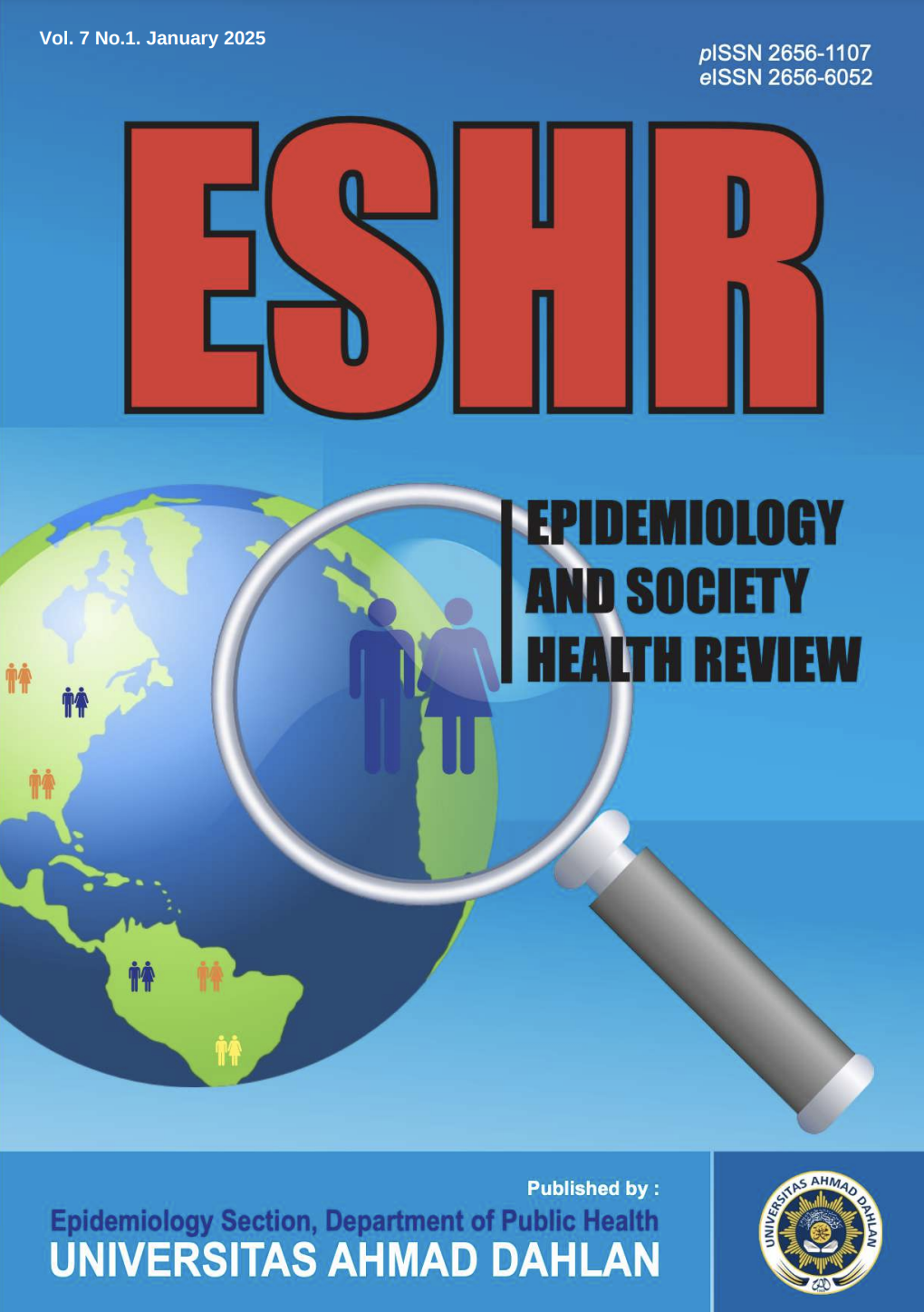Anaemia and Caesarean Section in Caucasian Race: Assessment of Risk Factors and Management Strategies
DOI:
https://doi.org/10.26555/eshr.v7i1.11332Keywords:
Anaemia, Anemia, Caesarean Section, Foetus, PregnancyAbstract
Background: Anaemia among pregnant women is a significant public health concern, particularly in developing countries, due to its adverse effects on both maternal and fetal health. This study addresses the gap in research regarding anaemia in pregnant women in northern Iran, specifically among those undergoing elective caesarean sections. The objective is to assess the prevalence of anaemia in this population.
Method: This retrospective cross-sectional study included 719 Caucasian pregnant women who were candidates for elective caesarean sections from September 2020 to March 2023. Patient data was collected from hospital electronic records. Anaemia was defined as haemoglobin <10.5 g/L in the three months before delivery and under 10 g/L after delivery. The Chi-square test was employed to compare anaemia prevalence across different demographic groups, with a significance level set at p-value < 0.05.
Results: Among the 719 participants, key demographic findings revealed that most had primary education (26.8%), while only 12.4% held university degrees. Most (59.8%) resided in urban areas, with the largest age group being 31-36 (30.5%). Most women (75.2%) reported no history of miscarriage, and 98.2% experienced no bleeding during pregnancy. Notably, 57.7% of women reported no underlying health conditions; however, 9.2% had gestational diabetes, while others had blood disorders, neurological issues, or gastrointestinal problems. The prevalence of anaemia among patients undergoing elective caesarean sections was found to be 10.85%. Anaemia was more prevalent in women aged 25-30 years.
Conclusion: integrating nutritional counselling into routine prenatal care can help address dietary deficiencies before they contribute to anaemia. Moreover, collaboration between healthcare providers and community leaders may foster greater acceptance of health interventions. By tailoring educational programs to local contexts and addressing specific cultural beliefs about nutrition and health, policymakers can create more effective strategies to combat anaemia in pregnant women.
References
World Health Organization (WHO). Worldwide prevalence of anaemia 1993–2005; WHO global database on anaemia 2008.
Stevens GA, Finucane MM, De-Regil LM, Paciorek CJ, Flaxman SR, Branca F, et al. Global, regional, and national trends in haemoglobin concentration and prevalence of total and severe anaemia in children and pregnant and non-pregnant women for 1995–2011: a systematic analysis of population-representative data. The Lancet Global Health. 2013;1(1):e16-e25. https://doi.org/10.1016/s2214-109x(13)70001-9
Excellence NIfC. National Collaborating Centre for Women’s and Children’s Health. Clinical Guideline CG62. Antenatal care: routine care for the healthy pregnant woman. London: National Institute for Clinical Evidence; 2008. 2012. https://www.ncbi.nlm.nih.gov/books/NBK51886/
Barroso F, Allard S, Kahan BC, Connolly C, Smethurst H, Choo L, Khan K, Stanworth S. Prevalence of maternal anaemia and its predictors: a multicentre study. Eur J Obstet Gynecol Reprod Biol. 2011 Nov;159(1):99-105. https://doi.org/10.1016/j.ejogrb.2011.07.041
Haider BA, Olofin I, Wang M, Spiegelman D, Ezzati M, Fawzi WW; Nutrition Impact Model Study Group (anaemia). Anaemia, prenatal iron use, and risk of adverse pregnancy outcomes: systematic review and meta-analysis. BMJ. 2013 Jun 21;346:f3443. https://doi.org/10.1136/bmj.f3443
Drukker L, Hants Y, Farkash R, Ruchlemer R, Samueloff A, Grisaru-Granovsky S. Iron deficiency anemia at admission for labor and delivery is associated with an increased risk for Cesarean section and adverse maternal and neonatal outcomes. Transfusion. 2015 Dec;55(12):2799-806. https://doi.org/10.1111/trf.13252
Azami, Darvishi, Borji, Sayeh Miri, Koresh. Prevalence of anaemia in Iranian pregnant women (2006-2017): a systematic review and meta-analysis. Quarterly Journal of Health Faculty and Health Research Institute. 2016 Jun 15;14(1):15-30.
Marchant TJ. The health of pregnant women in rural Tanzania with specific emphasis on anaemia and the impact of socially marketed insecticide-treated bednets: University of Basel; 2002.
Shulman CE, Graham WJ, Jilo H, Lowe BS, New L, Obiero J, Snow RW, Marsh K. Malaria is an important cause of anaemia in primigravidae: evidence from a district hospital in coastal Kenya. Trans R Soc Trop Med Hyg. 1996 Sep-Oct;90(5):535-9. https://doi.org/10.1016/s0035-9203(96)90312-0
van den Broek NR, Letsky EA. Etiology of anemia in pregnancy in south Malawi. Am J Clin Nutr. 2000 Jul;72(1 Suppl):247S-256S. https://doi.org/10.1093/ajcn/72.1.247s
Crawley J. Reducing the burden of anemia in infants and young children in malaria-endemic countries of Africa: from evidence to action. Am J Trop Med Hyg. 2004 Aug;71(2 Suppl):25-34.
Haas JD, Brownlie T 4th. Iron deficiency and reduced work capacity: a critical review of the research to determine a causal relationship. J Nutr. 2001 Feb;131(2S-2):676S-688S; discussion 688S-690S. https://doi.org/10.1093/jn/131.2.676s
Usanga EA, Chilaka M, Archibong EI. Prevalence of iron deficiency anaemia in Nigerian pregnant women. J Med Lab Sci. 1994; 4:113.
Levy A, Fraser D, Katz M, Mazor M, Sheiner E. Maternal anemia during pregnancy is an independent risk factor for low birthweight and preterm delivery. Eur J Obstet Gynecol Reprod Biol. 2005 Oct 1;122(2):182-6. https://doi.org/10.1016/j.ejogrb.2005.02.015
Bánhidy F, Ács N, Puhó EH, Czeizel AE. Iron deficiency anemia: pregnancy outcomes with or without iron supplementation. Nutrition. 2011 Jan;27(1):65-72. https://doi.org/10.1016/j.nut.2009.12.005
Kalaivani K. Prevalence & consequences of anaemia in pregnancy. Indian J Med Res. 2009 Nov;130(5):627-33. PMID: 20090119.
Walter T. Effect of iron-deficiency anemia on cognitive skills and neuromaturation in infancy and childhood. Food Nutr Bull. 2003 Dec;24(4 Suppl): S104-10. https://doi.org/10.1177/15648265030244s207
Geneva S, World Health Organization. The Prevalence of Anemia in Women: A Tabulation of Available Information. Document WHO/MCH/MSM/92.2; 1992.
McLean E, Cogswell M, Egli I, Wojdyla D, de Benoist B. Worldwide prevalence of anaemia, WHO Vitamin and Mineral Nutrition Information System, 1993-2005. Public Health Nutr. 2009 Apr;12(4):444-54. https://doi.org/10.1017/s1368980008002401
Senadheera D, Goonewardene M, Mampitiya I. Anaemia and iron deficiency in pregnant women attending an antenatal clinic in a Teaching Hospital in Southern Sri Lanka. Ceylon Med J. 2017 Sep 30;62(3):175-183. https://doi.org/10.4038/cmj.v62i3.8521
Adanikin AI, Awoleke JO. Sociodemographic factors associated with anaemia in pregnancy at booking for antenatal care. J Obstet Gynaecol. 2016;36(1):44-7. https://doi.org/10.3109/01443615.2015.1025727
Ikeanyi EM, Ibrahim AI. Does antenatal care attendance prevent anemia in pregnancy at term?. Niger J Clin Pract. 2015 May-Jun;18(3):323-7. https://doi.org/10.4103/1119-3077.151730
Amel Ivan E, A M. Evaluation of anaemia in booked antenatal mothers during the last trimester. J Clin Diagn Res. 2013 Nov;7(11):2487-90. doi: 10.7860/JCDR/2013/6370.3586. Epub 2013 Oct 25. https://doi.org/10.7860/JCDR/2013/6370.3586
Sinha M, Panigrahi I, Shukla J, Khanna A, Saxena R. Spectrum of anemia in pregnant Indian women and importance of antenatal screening. Indian J Pathol Microbiol. 2006 Jul;49(3):373-5. PMID: 17001888.
Yadav RK, Swamy M, Banjade B. Knowledge and Practice of Anemia among pregnant women attending antenatal clinic in Dr. Prabhakar Kore hospital, Karnataka-A Cross-sectional study. Literacy. 2014;30(34):18.
Lopez A, Cacoub P, Macdougall IC, Peyrin-Biroulet L. Iron deficiency anaemia. Lancet. 2016 Feb 27;387(10021):907-16. https://doi.org/10.1016/s0140-6736(15)60865-0
Wiesenack C, Meybohm P, Neef V, Kranke P. Current concepts in preoperative anemia management in obstetrics. Curr Opin Anaesthesiol. 2023 Jun 1;36(3):255-262. doi: 10.1097/ACO.0000000000001252. Epub 2023 Feb 27. https://doi.org/10.1097/ACO.0000000000001252
Balarajan Y, Ramakrishnan U, Ozaltin E, Shankar AH, Subramanian SV. Anaemia in low-income and middle-income countries. Lancet. 2011 Dec 17;378(9809):2123-35.
Camaschella C. Iron-deficiency anemia. N Engl J Med. 2015 May 7;372(19):1832-43. https://doi.org/10.1056/nejmra1401038
Downloads
Published
Issue
Section
License
Copyright (c) 2025 Yaser Khakpour, Mahshid Moradi Heidarlou, Shahram Shukohi, Mahla Akbari

This work is licensed under a Creative Commons Attribution-ShareAlike 4.0 International License.
Authors who publish with ESHR agree to the following terms:
- Authors retain copyright and grant the journal right of first publication with the work simultaneously licensed under a Creative Commons Attribution License (CC BY-SA 4.0) that allows others to share the work with an acknowledgment of the work's authorship and initial publication in this journal.
- Authors are able to enter into separate, additional contractual arrangements for the non-exclusive distribution of the journal's published version of the work (e.g., post it to an institutional repository or publish it in a book), with an acknowledgment of its initial publication in this journal.
- Authors are permitted and encouraged to post their work online (e.g., in institutional repositories or on their website) prior to and during the submission process, as it can lead to productive exchanges, as well as earlier and greater citation of published work.












